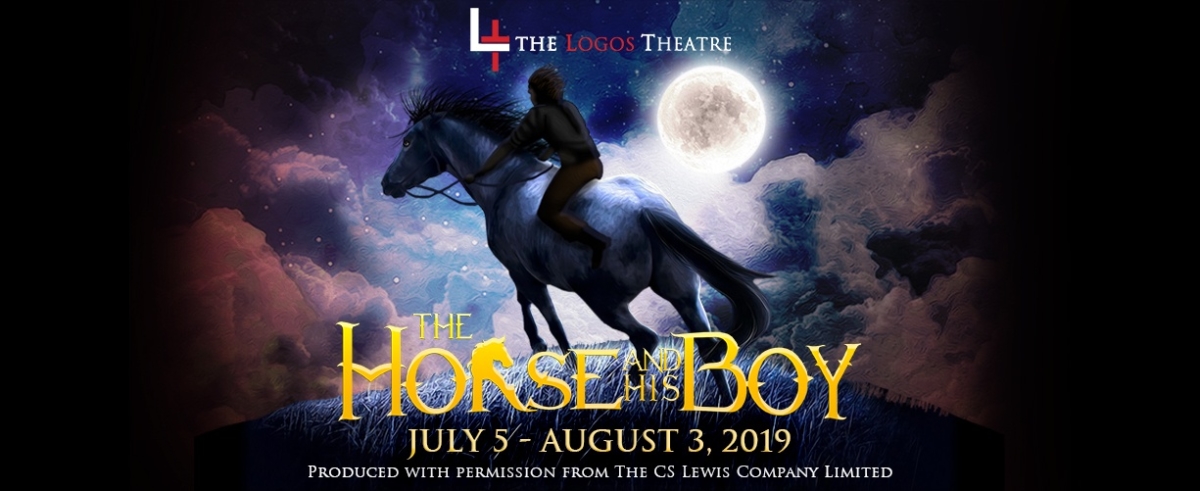THIS EVENT HAS PASSED! PLEASE CLICK ON THE BUTTON BELOW TO PURCHASE TICKETS TO OUR UPCOMING JULY-AUGUST PRODUCTION.
***Douglas Gresham will not be in attendance at the upcoming July-August performances
Opening Night for The Horse and His Boy is almost here, and we have an incredible evening planned that we could not wait to share! Opening weekend only, ALL audience members are invited to join us on the Red Carpet to take photos, meet our cast and puppeteers, and be the first to walk through the doors for the US Premier of The Horse and His Boy! *This special event is FREE to all ticket holders for opening weekend and will include coffee and concessions.
During intermission, Douglas Gresham (our special guest and stepson of CS Lewis) will be available for “tea and turkish delight” in our conference room. Fifteen special guests can enjoy this personal time of conversation and refreshments with Mr. Gresham while surrounded with Narnian props and costumes from the official motion pictures of The Lion, the Witch, and the Wardrobe, Prince Caspian, and the Voyage of the Dawn Treader. Guests will also receive a signed print by Mr. Gresham as a memento of the occasion! *Admission to the Intermission Tea and Turkish Delight event is limited to 15 per night. Guests may obtain passes for this event for $50 by contacting Jennifer Swain at 864-268-9342 extension 011)
As the performance ends, guests who purchase a backstage pass will have the opportunity to greet Mr. Gresham, take a photo and have him sign any memento from our gift shop on the Logos stage. *Guests may obtain backstage passes for $10 by contacting Jennifer Swain at 864-268-9342 extension 011 or in person at the Logos Gift Shop at the performance.
If you have yet to purchase your tickets for The Horse and His Boy, join us for opening weekend and unforgettably experience another Narnian adventure before tickets are gone!
We will see you on the Red Carpet.
WHY THE HORSE AND HIS BOY?
After performing The Lion, the Witch and the Wardrobe, The Logos Theatre has been blessed to be the only theatre in the world to put on the professional premiere of Prince Caspian on the stage. Douglas Gresham, the step-son of C.S. Lewis, was able to fly over from the island of Malta to be here at The Logos for the opening premiere of that performance, and it was met with overwhelming positive reviews from the public. People from all over the country came to see the performance, and a few even came from other countries! The Logos was blessed to be able to put this fantastic production on the stage with the unbelievable and sacrificial efforts of its staff.
With no major outside funding, The Logos was able to dig deep and use all the creativity and resources it had to put a truly remarkable production on the stage that honored the unbelievable Narnian story that is beloved, the world over.
Now, The Logos is moving forward with The Horse and His Boy and we will be the first theatre in the United States to do this production on stage in a professional manner. Once again, we have the privilege of welcoming Douglas Gresham to the opening 2 performances on March 1 and 2, 2019 where he will be our guest of honor. C.S. Lewis actually dedicated this book directly to Mr. Gresham and his brother David, when they were 9 and 11 years old respectively. So, this story holds special significance to Doug Gresham, and we are beyond thrilled that he will be able to see the United State professional premiere!
HOW IS THIS DIFFERENT FROM OTHER NARNIAN PRODUCTIONS?
There are a number of things that set apart The Logos Theatre’s performances from others.
First, the puppets. Our staff has already built Aslan (a giant puppet – 10 feet long, 5 feet tall and run by 3 people) which magnificently depicts the Great Lion in Lewis’ books. We have also built a life-size horse run by 3 people, which played the part of Caspian’s horse, Destrier, in Prince Caspian. Now, as we are preparing for The Horse and His Boy, our team is constructing 2 more life-size horse puppets who will be Bree and Hwin in the production, as well as a large cat, which Shasta meets in the tombs. These intricate and incredibly complex puppet animals, bring a vivid realism to the stories on the stage as the puppeteers expertly move them and bring them to life.
Secondly, our moving set pieces and scene changes. Nicole Stratton, our Artistic Director, has come up with a brilliant way of implementing each scene change and the movement of the set pieces into part of the action on the stage. We’ve heard many comments from audience members who felt like just The Logos Theatre’s scene changes were worth the price of admission. Come and see for yourself!
Thirdly, the story itself. We are purists on our stage productions, meaning that we always stick as close as absolutely possible to what the original story or book says. We don’t take “artistic liberties” just because we can. We always stick to the original words and intentions of the author.
So anyone who comes to see the story that they have grown up reading as a child will not go away disappointed since they will be seeing that exact story on the stage.
SUMMARY
Released in 1954, The Horse and His Boy is the fifth novel of seven published in the The Chronicles of Narnia. Written before the first book was even out and for the first and only time featuring native Narnian children, The Horse and His Boy tells the story of a young boy, Shasta, who as a baby, is found by Arsheesh, a fisherman from Calormen. At the novel’s opening, Shasta overhears Arsheesh discussing selling the boy to a Calormen nobleman named Anradin. Shasta is happy to learn from his eavesdropping that Arsheesh is not his real father. As Shasta waits for Anradin by the stables, Bree, Anradin’s beautiful horse, begins talking to him, much to his amazement. Bree reveals that he is a talking horse from Narnia captured by the Calormenes when he was younger. Anradin will be a cruel master, he explains, and Shasta decides to escape. Bree suggests they escape together to Narnia. Shasta agrees.
They soon meet another pair, also escaping to Narnia: Aravis, a young aristocrat from Calormen, and her talking horse, Hwin. Aravis is fleeing from an arranged marriage to the much older grand vizier Ahoshta.
The four travel through the Calormen capital of Tashbaan. There, a group of Narnians mistake Shasta for Prince Corin, and Shasta only escapes their attention when the real prince finally arrives.
At the same time, Aravis has been spotted and recognized by her friend Lasaraleen. When Aravis asks Lasaraleen not to reveal her plans, Lasaraleen does not understand why Aravis would want to abandon the life of a noblewoman. Still, Lasaraleen helps Aravis escape. While hiding in a garden, they overhear a plan by Ahoshta and some others for invading Narnia. The plan will be successful, they hope, because the children from The Lion, The Witch, and The Wardrobe are distracted with other matters and battles.
Aravis and Shasta reunite with their horses, and Aravis explains the invasion plot. They head out into the desert, where they encounter a lion they later learn is Aslan from the Narnia books.
Aslan purposefully frightens them, which allows them to outrun the invasion force. They are able to warn the defenders in time for them to prepare to meet the invasion force, allowing them to resist the siege long enough for the Narnia relief force to arrive.
Rabadash, a leader of the invasion force, is offered a conditional release. When he refuses, Aslan turns him into a donkey. To return to his true form, he must stand before the altar of Tash, and then never live more than ten miles from the altar. This ensures that he will pursue peaceful relations with his neighbors.
The victorious king recognizes Shasta as the long-lost twin of the Prince, and his return and the warning that he brought fulfilled an important prophecy. Shasta and Aravis stay there, and eventually marry. Their son, Ram, goes on to become a famous king.
HISTORY AND BACKGROUND
The Horse And His Boy is a novel set in Lewis’s world of Narnia, and the events of this novel take place during the time of the last chapter of The Lion, The Witch, and the Wardrobe. This is the only Narnia book to star characters from Narnia, though the Pevensies—the children who enter Narnia from our world using the wardrobe—appear as minor characters.
The characters from The Horse and His Boy make an appearance in the later Narnia book, The Last Battle.
As with all Narnia-related books, Lewis makes connections to religion and spirituality. Aslan, the Lion whom Lewis uses as a Christ-like figure, appears to the characters as a powerful figure who is working behind the scenes in the events of everyone’s story. As such, the book comments on the nature of Divine Providence. The characters, like the novel’s readers, are subject to both the support and the retribution of God, and as such, we should live our lives accordingly. These truths are paramount for each of us to remember and the play brilliantly illustrates these truths so that the audience members go away challenged in their thinking and in their actions.
Though Aslan is depicted as powerful and potentially quite dangerous, he is also caring toward and supportive of his followers. The events in the book unfold as he sees fit, and his unseen hand pushes the story’s directions.
One of the other important themes in the book, which also connects to its Christian origins, is the concept of the danger of pride and the importance and power of humility. The prideful natures of several characters lead them into poor decisions and disastrous circumstances. The humble people, however, who seek to serve others, are lifted up in the end.
GET YOUR TICKETS NOW!!
We do hope that you will make your plans to come and join us for this historical and unprecedented production!



